Ear piercing is a timeless form of self-expression‚ rooted in history and thriving in modern culture. It offers versatility for all styles‚ from subtle to bold designs. This guide covers everything from types of piercings to aftercare‚ ensuring a safe and stylish experience.
1.1 Historical Background of Ear Piercing
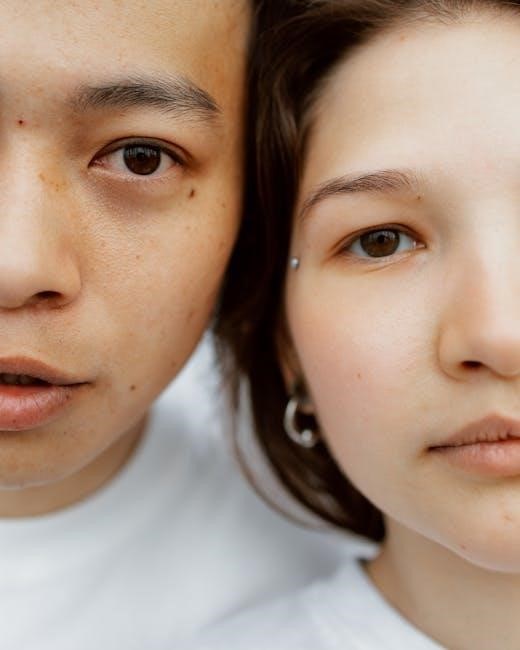
Ear piercing dates back thousands of years‚ with evidence of its practice in ancient civilizations like Egypt‚ Rome‚ and Africa. It symbolized cultural identity‚ spiritual beliefs‚ and social status. In many cultures‚ piercings were rituals marking transitions to adulthood. The oldest known pierced mummy‚ Ötzi‚ had ear piercings dating to 3300 BCE. By the Middle Ages‚ ear piercing became a status symbol in Europe. In the 20th century‚ it evolved into a mainstream fashion statement‚ blending tradition with modern style.
1.2 Popularity of Ear Piercing in Modern Times
Ear piercing has surged in popularity‚ becoming a cultural phenomenon. Social media platforms like Instagram and TikTok showcase diverse styles‚ inspiring individuals to embrace unique looks. Celebrities and influencers often highlight bold designs‚ from delicate studs to edgy cartilage piercings. With advancements in jewelry and techniques‚ ear piercing appeals to all ages‚ blending creativity with personal identity. Its versatility allows for subtle elegance or striking statements‚ making it a timeless trend in modern fashion.
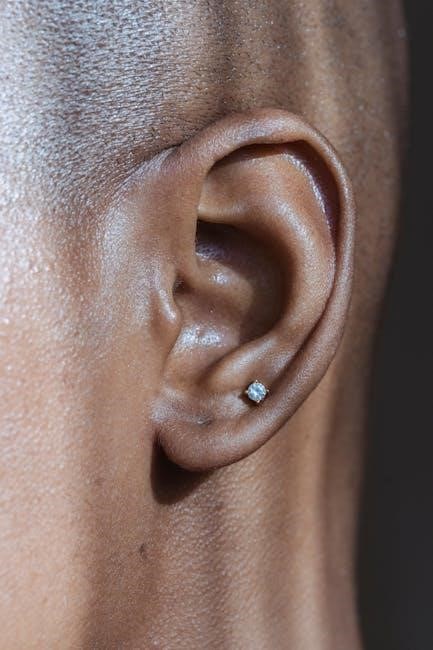
Types of Ear Piercings
Ear piercings come in various styles‚ from classic lobe to trendy cartilage options like tragus‚ helix‚ and daith. Each type offers unique aesthetics and placement possibilities.
2.1 Lobe Piercings
Lobe piercings are the most classic and popular type‚ located on the soft‚ fleshy part of the earlobe. They are versatile‚ suitable for all ages‚ and offer a wide range of jewelry options. Healing typically takes 6-8 weeks‚ making them a great choice for first-time piercings. Their simplicity and low maintenance make lobe piercings a timeless favorite‚ perfect for subtle or bold styling.
2.2 Cartilage Piercings
Cartilage piercings are located on the upper‚ firmer part of the ear‚ offering a stylish and edgy aesthetic. Healing times range from 6 to 12 months‚ requiring diligent aftercare. They are less common than lobe piercings but highly popular for their unique appeal. Popular jewelry options include studs and small hoops. Cartilage piercings are ideal for those seeking a modern‚ trendy look‚ though they may be more sensitive during the piercing process.
2.3 Tragus Piercings
Tragus piercings are located on the small flap of cartilage in front of the ear canal‚ offering a delicate and unique aesthetic. They are less common than other piercings but highly sought after for their subtle appeal. Healing typically takes 8-16 months‚ requiring consistent aftercare. Small studs or hoops are popular jewelry choices. Tragus piercings are ideal for those looking for a understated yet stylish addition to their ear. While trendy‚ they may be more sensitive during the piercing process due to the area’s thickness.
2.4 Helix Piercings
Helix piercings are located on the upper rim of the ear‚ offering a stylish and versatile option. They are popular for their minimalist appeal and can be adorned with studs‚ hoops‚ or dainty jewelry. Healing typically takes 6-12 months‚ with proper aftercare essential to avoid complications. The helix is a great choice for those exploring cartilage piercings‚ as it is relatively less sensitive compared to other areas. Its visibility makes it a favorite for everyday styling‚ allowing for both subtle and bold looks depending on the jewelry selected.
2.5 Daith Piercings
Daith piercings are situated on the inner cartilage of the ear‚ near the ear’s opening‚ offering a unique and edgy aesthetic. Often linked to anecdotal benefits like migraine relief‚ this piercing is both stylish and intriguing. Healing typically takes 6-12 months‚ requiring diligent aftercare to prevent complications. While not scientifically proven‚ many find personal benefits. The daith piercing is moderately painful and pairs well with rings or studs‚ making it a popular choice for those seeking a distinctive look.
2.6 Rook Piercings
Rook piercings are located in the upper portion of the ear‚ within the cartilage fold. They are known for their bold‚ edgy appearance and moderate pain level. Healing typically takes 6-12 months‚ requiring consistent aftercare to avoid complications. This piercing is ideal for those who enjoy unique styles‚ as it stands out while remaining versatile. Proper cleaning and avoiding tight jewelry are key for smooth healing. The rook piercing is a great choice for individuals looking to add a striking touch to their ear aesthetic;
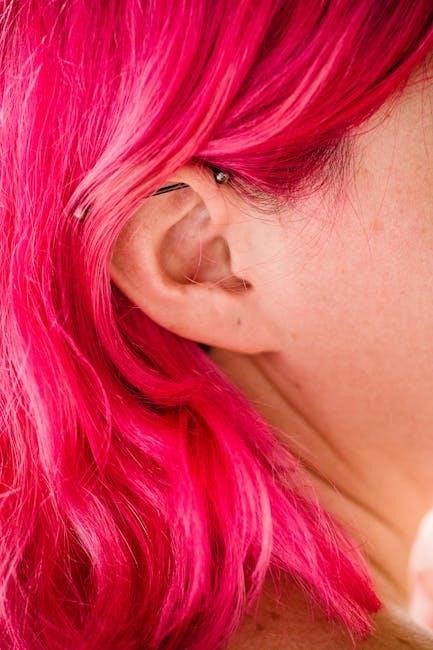
2.7 Conch Piercings
Conch piercings are located in the shell-like area of the ear‚ offering a sleek‚ customizable look. They can be inner or outer‚ depending on placement. Healing typically takes 6-12 months‚ requiring diligent aftercare to prevent complications. Known for moderate pain‚ conch piercings are ideal for those seeking a stylish‚ versatile addition to their ear. Proper jewelry selection and care are essential for a smooth healing process‚ making this piercing a popular choice for unique‚ eye-catching designs.
2.8 Anti-Tragus Piercings
Anti-tragus piercings are located on the small flap of cartilage opposite the tragus‚ offering a unique‚ less common aesthetic. Healing typically takes 6-12 months‚ with moderate pain during the procedure. This piercing suits those seeking a subtle yet distinctive look. Proper aftercare is essential to avoid complications‚ emphasizing regular cleaning and avoiding tight jewelry. Anti-tragus piercings are popular for their understated style and versatility‚ making them a great choice for those exploring beyond traditional ear piercings.
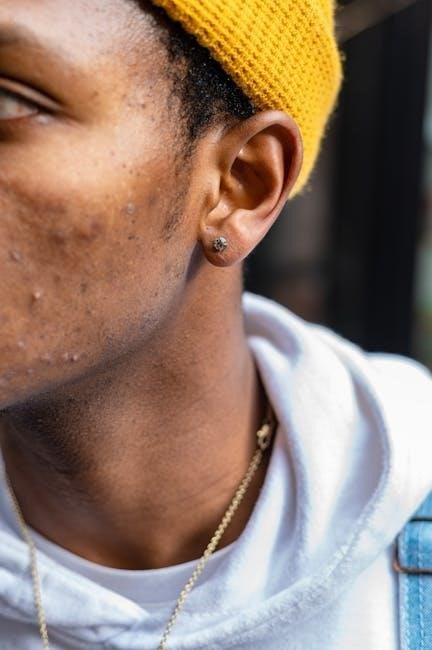
The Ear Piercing Process
The ear piercing process involves selecting a professional‚ preparing the area‚ executing the piercing‚ and following aftercare instructions for proper healing‚ ensuring a clean environment and using proper tools.
3.1 Choosing the Right Piercer
Choosing the right piercer is crucial for a safe and successful experience. Ensure they are licensed‚ experienced‚ and follow proper hygiene practices. A reputable piercer will use sterile equipment and provide clear aftercare instructions. Look for certifications‚ such as membership in professional organizations like the Association of Professional Piercers (APP). Visit the studio to assess cleanliness and organization. A professional piercer will guide you through the process and help you feel comfortable. Avoid inexperienced piercers to minimize risks and ensure proper healing. Your piercer’s expertise directly impacts the outcome and safety of your piercing.
3.2 Pre-Piercing Preparations
Proper preparation is essential for a smooth ear-piercing experience. Ensure your skin is clean and free of lotions or oils. Wear comfortable‚ easy-to-access clothing. Avoid eating heavy meals beforehand and stay hydrated. Refrain from alcohol or caffeine‚ as they can increase sensitivity. Mentally prepare by understanding the process and discussing any concerns with your piercer. Remove any jewelry that could interfere and arrive with a clear idea of the piercing location. Proper preparation ensures a safe‚ stress-free experience and promotes optimal healing conditions.
3.3 The Piercing Procedure
The piercing procedure involves a sterile needle or piercing gun‚ depending on the type of piercing. The area is cleaned and marked for accuracy. The piercer ensures proper alignment before creating the hole. Jewelry is inserted immediately to keep the hole open. You may feel a brief pinch or pressure‚ but the process is quick. Professional piercers follow strict hygiene protocols to minimize risks. Stay calm‚ breathe deeply‚ and follow instructions to ensure a smooth experience. The procedure typically takes only a few seconds‚ with aftercare instructions provided post-piercing.
3.4 What to Expect During the Process
During the piercing process‚ expect a quick and straightforward procedure. The area is cleaned and marked for accuracy. You might feel a slight pinch or pressure when the needle or piercing gun is used. Some people describe it as a brief discomfort‚ while others find it nearly painless. The piercer will guide you through deep breathing to stay relaxed. After the piercing‚ jewelry is inserted‚ and aftercare instructions are provided. The entire process is typically over in seconds‚ leaving you with a fresh‚ stylish piercing to enjoy.

Aftercare and Healing
Proper aftercare is crucial for smooth healing. Keep the area clean‚ avoid irritants‚ and follow care routines. Healing times vary depending on piercing type and location.
4.1 General Aftercare Tips
Proper aftercare ensures smooth healing and prevents complications. Clean the piercing regularly with saline solution‚ avoiding harsh chemicals. Keep the area dry and avoid tight clothing. Gently rotate jewelry to prevent irritation. Avoid submerging in water until healed. Refrain from playing with jewelry‚ as it can cause damage. Monitor for signs of infection‚ such as redness or swelling. Maintain good hygiene and avoid sharing jewelry. Healing times vary‚ so patience and consistency are key. Always follow professional advice for optimal results.
4.2 Cleaning and Maintenance
Regular cleaning is essential for healing. Use a saline solution (1/4 teaspoon of sea salt in 8 oz of warm water) 2-3 times daily. Gently soak a clean cotton ball and wipe the piercing‚ avoiding harsh chemicals. Pat dry with a clean towel; never rub. Avoid submerging in water until fully healed. Keep jewelry clean and free from residue. Regular maintenance ensures a smooth recovery and prevents complications.
4.3 Common Mistakes to Avoid
Avoid touching the piercing excessively‚ as this can introduce bacteria. Never use harsh chemicals or rotate the jewelry excessively. Tight jewelry can restrict blood flow‚ while loose jewelry may catch on objects. Overcleaning can irritate the area; stick to saline solution. Ignoring aftercare instructions from professionals is a common oversight. Lastly‚ avoid submerging the piercing in water‚ like swimming‚ until fully healed. These mistakes can delay healing and lead to complications‚ so adherence to proper care routines is crucial for a smooth recovery.
4;4 Healing Times for Different Piercings
Healing times vary depending on the piercing location and individual anatomy. Earlobe piercings typically heal within 6-8 weeks‚ while cartilage piercings‚ such as helix or tragus‚ may take 3-6 months. Daith and rook piercings often require 6-9 months for full healing. Proper aftercare significantly influences recovery speed. It’s essential to follow professional advice to avoid delays. Keep in mind that healing times can differ‚ so patience and consistent care are key for optimal results.
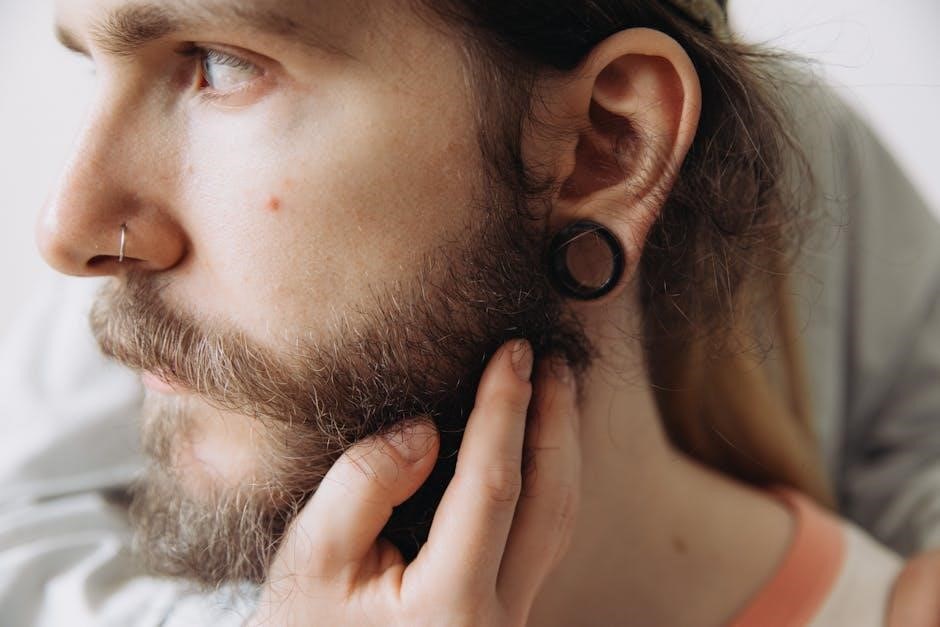
Styling and Jewelry Options
Explore various jewelry styles‚ from studs to hoops‚ to enhance your ear piercings. Choose designs that complement your piercing type and personal aesthetic for a unique look.
5.1 Types of Jewelry for Ear Piercings
Ear piercing jewelry comes in various styles to suit different preferences. Studs are perfect for minimal looks‚ while hoops add a bold‚ elegant touch. Labret studs and clickers are popular for cartilage piercings‚ offering comfort and ease. Dangle earrings and huggies add movement and personality‚ ideal for layered looks. Choose jewelry that complements your piercing type‚ personal style‚ and lifestyle for a polished‚ unique aesthetic.
5.2 Styling Tips for Multiple Piercings
Styling multiple ear piercings allows for creative expression. Balance is key—mix delicate studs with bold hoops or dangle earrings. Pair minimalist designs with statement pieces for contrast. Consider symmetry or asymmetry based on your preference. Layer smaller hoops with larger ones for depth. Experiment with textures like matte‚ glossy‚ or metallic finishes. Don’t over-accessorize; let each piercing shine. Personalize your look by matching jewelry to your outfit or mood. Remember‚ less can be more—focus on a few standout pieces for a polished‚ trendy aesthetic.
5.3 Popular Trends in Ear Piercing Jewelry
Current trends in ear piercing jewelry emphasize minimalism and personalization. Delicate studs‚ hoop earrings‚ and dainty drops remain popular for their versatility. Engravable pieces and customizable designs are also in demand‚ allowing individuals to add unique touches. Celebrities often inspire trends‚ with sleek‚ elegant styles gaining traction. Statement jewelry‚ such as bold clusters or crystal-embellished pieces‚ offers a glamorous alternative. Sustainable materials‚ like ethically sourced metals‚ are increasingly favored. Mixing textures and finishes adds depth to ear stacks‚ while layering multiple piercings creates a trendy‚ polished look.
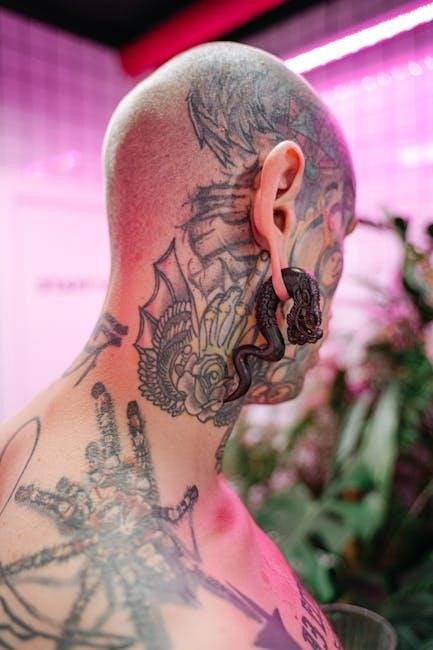
Risks and Complications
Ear piercings carry risks like infections‚ allergic reactions‚ and complications if not properly cared for. Proper aftercare is essential to minimize these risks and ensure safe healing.
6.1 Infection Risks and Prevention
Infections are a common risk with ear piercings if proper aftercare is neglected. To prevent infections‚ clean the piercing regularly with saline solution‚ avoid touching the area excessively‚ and keep jewelry tight. Avoid submerging the piercing in water‚ such as in pools or hot tubs‚ until fully healed. Redness‚ swelling‚ or discharge may indicate an infection‚ requiring immediate attention. Choosing high-quality‚ hypoallergenic jewelry and maintaining hygiene are crucial steps to minimize infection risks and promote smooth healing.
6.2 Allergic Reactions to Jewelry
Allergic reactions to jewelry are common‚ often caused by sensitivity to metals like nickel. Symptoms include redness‚ itching‚ and swelling around the piercing. To avoid this‚ opt for hypoallergenic materials such as surgical stainless steel‚ titanium‚ or niobium. If a reaction occurs‚ switch to a different jewelry type and consult a professional piercer. Proper jewelry selection is essential for preventing discomfort and ensuring a smooth healing process.
6.3 Common Complications and Solutions

Common complications from ear piercings include infections‚ bumps‚ and jewelry migration. Infections can arise from poor aftercare and are treatable with saline soaks. Bumps‚ often caused by irritation‚ can be minimized with gentle cleaning. Jewelry migration may occur if the piercing is not fully healed. To address these issues‚ maintain proper hygiene‚ avoid tight jewelry‚ and consult a professional piercer for adjustments. Early intervention and proper care can prevent long-term discomfort and ensure a smooth recovery process for all types of ear piercings.
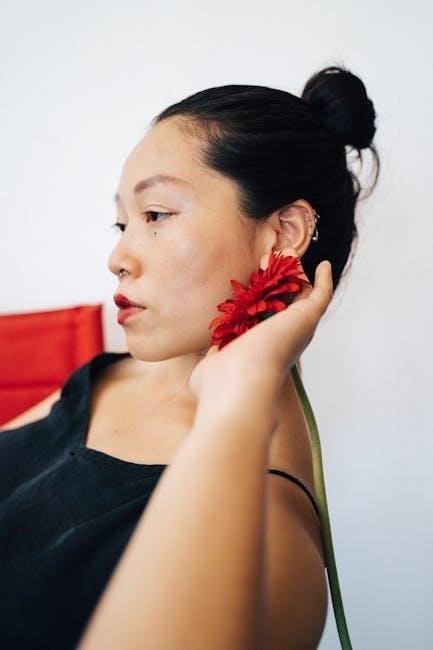
Ear Piercing for Specific Groups
Ear piercing suits teenagers‚ adults‚ and those with sensitive skin. Proper aftercare and jewelry selection are crucial for each group to ensure safe and successful outcomes.
7.1 Ear Piercing for Teenagers
Ear piercing is a popular way for teenagers to express their individuality. It’s important to choose a reputable piercer and ensure proper aftercare to promote healing. Teens should opt for hypoallergenic jewelry‚ like surgical stainless steel or titanium‚ to minimize the risk of allergic reactions. Parental consent is often required for minors. Styling options range from subtle studs to more elaborate designs‚ allowing teens to personalize their look while maintaining a clean and professional appearance. This rite of passage can be a memorable and empowering experience when done safely and responsibly.
7.2 Ear Piercing for Adults
Ear piercing for adults has become a popular way to refresh personal style or celebrate milestones. Many adults opt for unique piercings like helix‚ tragus‚ or conch for a sleek‚ modern look. Proper aftercare is essential‚ especially for those with sensitive skin. Adults often choose high-quality jewelry‚ such as solid gold or platinum‚ to minimize irritation. Styling options range from minimalist studs to elaborate stacks‚ allowing for endless creativity. Whether it’s a subtle addition or a bold statement‚ ear piercing offers a timeless way for adults to express their individuality and confidence.
7.3 Ear Piercing for Sensitive Skin
For individuals with sensitive skin‚ choosing the right jewelry and aftercare is crucial. Opt for hypoallergenic materials like solid gold or platinum to minimize irritation. Gentle cleaning products‚ such as saline solutions‚ are recommended to avoid harsh reactions. Avoid tight or poorly fitting jewelry‚ as it can cause discomfort. Healing times may vary‚ and redness or swelling should be monitored. Consulting a professional piercer experienced with sensitive skin can help ensure a smooth experience. Proper care and patience are key to maintaining healthy‚ comfortable piercings.
Ear piercing is a personal journey of self-expression. Choose a reputable piercer‚ follow aftercare tips‚ and embrace your unique style. Patience and proper care ensure lasting results.
8.1 Summing Up the Guide
This guide has covered the essentials of ear piercing‚ from types and aftercare to styling and risks. Whether you’re a teenager or an adult‚ ear piercing is a timeless form of self-expression. By choosing a reputable piercer‚ following proper aftercare‚ and embracing your personal style‚ you can enjoy a safe and rewarding experience. Remember‚ patience and consistency are key to achieving optimal results and maintaining your piercing’s health and aesthetic appeal.
8.2 Encouragement and Final Advice
Embrace your uniqueness and take the plunge into ear piercing with confidence! Whether you’re a teenager or an adult‚ this is a personal journey of self-expression. Explore various styles‚ from subtle lobe piercings to bold cartilage designs. Always prioritize a reputable piercer and diligent aftercare for optimal results. Remember‚ patience is key—proper healing leads to a stunning‚ long-lasting look. Celebrate your individuality and enjoy the transformative experience of ear piercing!
